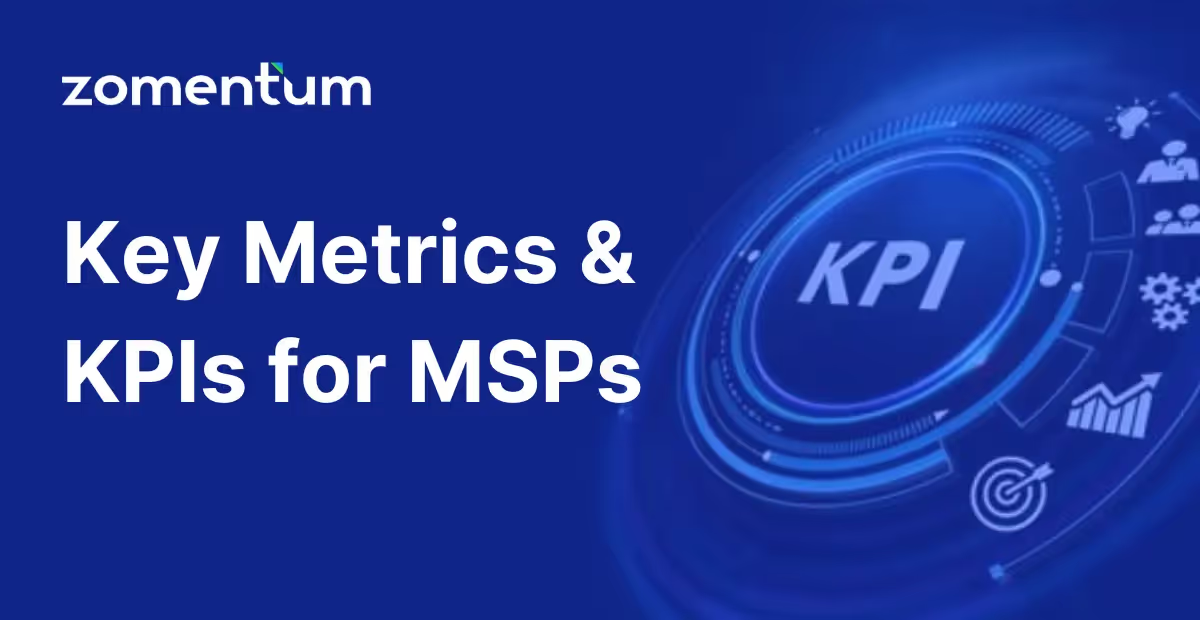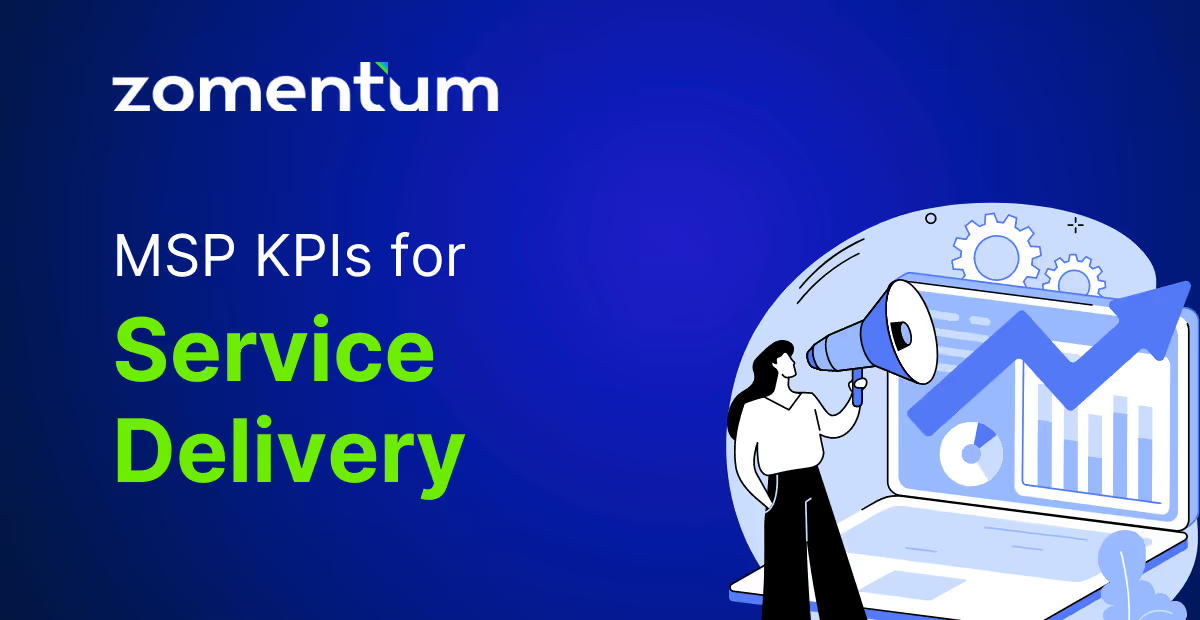21 MSP KPIs to Measure for Business Performance

The competition never stops growing, which means it's not enough for MSPs to rely solely on their expertise and reputation to grow their business. You must effectively measure and optimize your performance to stand out and demonstrate your value.
This is where managed service provider KPIs (Key Performance Indicators) come into play.
Managed Service KPIs can help you gain valuable insights into your operations, streamline your processes, and ultimately enhance your client experience. These metrics allow you to assess how efficient your managed service provider (MSP) business is, right from client onboarding to service delivery.
Measuring your MSP performance enables you to showcase your value to your clients and empowers you to improve and adapt to a highly evolving industry.
This blog will explore the essential MSP KPIs you must track to optimize your operations and drive sustainable growth.
Let's dive right in!
List of MSP KPIs You Must Measure
We’ve divided the MSP KPIs into seven categories, from client onboarding to overall business growth. Though the list of manager service KPIs is not limited to the ones mentioned in this blog, these are some that you must track.
Let’s measure your MSP performance with these KPIs:
MSP KPIs for Client Onboarding
1. Time to Onboard a New Client
Time to onboard a new client refers to the duration it takes from the initial engagement with a client to complete the onboarding process and have them fully operational.
Calculating it can help you identify bottlenecks, streamline processes, and improve operational efficiency. It also sets client expectations and allows you to assess your ability to scale and handle new clients effectively.
It’s essential to note that while calculating the time to onboard new clients, you should exclude any delays caused by client dependencies or external factors.
2. Number of Successful Client Onboarding Processes

It refers to the number of clients who have been successfully onboarded and are actively using your services.
Tracking the number of successful client onboarding processes helps evaluate if your onboarding process is effective. It also indicates your ability to meet client expectations and deliver value.
3. Client Satisfaction With the Onboarding Process
This MSP KPI measures how satisfied clients are with the experience of being onboarded onto your services.
Calculating this managed services KPI helps gauge the effectiveness of your onboarding efforts, identify areas for improvement, and ensure a positive initial experience. With a positive initial experience, the clients are more likely to remain loyal and provide referrals.
MSPs can use client satisfaction surveys or feedback mechanisms, such as ratings or Net Promoter Score (NPS), to gather client opinions and assess their satisfaction with the onboarding process.

MSP KPIs for Service Delivery
4. Response Time to Client Requests or Incidents
Response time to client requests measures the duration between when a client submits a request or reports an incident and when your MSP initiates a response. The quicker you are, the better.
Calculating response time helps assess the timeliness and effectiveness of your support services. It directly impacts customer satisfaction, as clients expect prompt attention to their needs.
Response Time = Time of Response Initiation - Time of Request Submission/Incident Report
5. Mean Time to Resolution (MTTR) for Client Issues
Mean time to resolution (MTTR) is the average time taken to resolve client issues or incidents from the moment they are reported.
Calculating this managed services KPI provides insights into the efficiency and effectiveness of your support team in resolving client issues. A shorter MTTR indicates faster problem resolution and better service quality, leading to reduced business impact caused by incidents.
MTTR = Total Resolution Time / Number of Resolved Issues
6. Service Level Agreement (SLA) Compliance

This is one of the essential MSP KPIs to track as it measures the extent to which your MSP meets the agreed-upon service levels and performance targets outlined in the SLA template with your clients.
Calculating SLA compliance ensures that your MSP delivers services as promised, meeting client expectations and contractual obligations. It also provides a basis for evaluating your performance against agreed-upon benchmarks.
SLA Compliance (%) = (Number of SLA-compliant Incidents / Total Number of Incidents) x 100
MSP KPIs for Resource Utilization
7. Technician Utilization Rate
Technician utilization rate measures the percentage of time that technicians spend on billable activities or tasks compared to their total available working hours.
It’s essential to track this MSP KPI to assess the efficiency and effectiveness of your workforce utilization. It allows you to optimize resource allocation, identify potential capacity constraints, and ensure that technicians are maximizing their billable hours.
Technician Utilization Rate (%) = (Total Billable Hours / Total Available Working Hours) x 100
8. Technician Productivity
It measures the number of tasks or tickets technicians complete within a specific timeframe. It provides insights into their workload and contribution to meeting client needs and SLAs. The formula is simply the count of completed tasks.

9. Time Spent on Non-billable Activities
Time spent on non-billable activities refers to the duration that technicians allocate to non-revenue-generating tasks, such as training, administrative work, or internal meetings.
Keeping track of these MSP KPIs helps optimize task distribution, manage non-billable activities effectively, and ensure that billable time is maximized.

MSP KPIs for Financial Performance
10. Revenue per Client
It’s the total revenue generated from an individual client within a specific period. Calculating revenue per MSP contract helps evaluate the value and profitability of each client. It enables you to identify high-value clients, determine the effectiveness of your pricing strategies, and make informed decisions regarding resource allocation and client retention efforts.
Revenue per Client = Total Revenue / Number of Clients
11. Gross Profit Margin
Gross profit margin is the percentage of revenue remaining after deducting the direct costs associated with delivering services.
It helps assess the profitability of your MSP's services. It also enables you to analyze the cost-effectiveness of service delivery, make pricing adjustments, and monitor the financial health of your business.
Gross Profit Margin (%) = ((Total Revenue - COGS) / Total Revenue) x 100
12. Monthly Recurring Revenue (MRR) Growth Rate
The monthly recurring revenue (MRR) growth rate measures the rate at which your MRR is increasing or decreasing over a specific period.
Calculating the MRR growth rate helps track the financial performance and business growth of your MSP. It provides insights into the effectiveness of your MSP sales and marketing efforts, client retention strategies, and overall revenue trajectory.
MRR Growth Rate (%) = ((Current MRR - Previous MRR) / Previous MRR) x 100
13. Cost per Client
Cost per client represents the average cost incurred by your MSP to acquire, serve, and support each client.
It helps evaluate the profitability and cost-efficiency of your client base and assists in making informed decisions regarding pricing, resource allocation, and client acquisition strategies.
Cost per Client = Total Costs / Number of Clients

MSP KPIs for Customer Satisfaction and Engagement
14. Net Promoter Score (NPS)
Net Promoter Score (NPS) is a metric that measures customer loyalty and satisfaction by gauging their likelihood to recommend your MSP to others.
It provides valuable insights into your brand perception, identifies promoters and detractors, and serves as a benchmark for tracking customer sentiment over time. Send a survey to clients asking them to rate, on a scale of 0-10, how likely they are to recommend your MSP. Calculate the NPS by subtracting the percentage of detractors (scores 0-6) from the percentage of promoters (scores 9-10).
15. Number of Client Referrals
The number of client referrals measures the count of new clients acquired through recommendations or referrals from existing clients.
It indicates the level of trust and positive word-of-mouth generated by your services, leading to potential business growth and reduced client acquisition costs.
16. Client Engagement Level
Client engagement level measures the level of interaction, involvement, and overall relationship strength between your MSP and its clients.
This MSP KPI helps assess the quality of your client relationships and the extent to which clients actively engage with your services. It enables you to identify opportunities for upselling, cross-selling, and providing additional value to clients.

MSP KPIs for Security and Compliance
17. Number of Security Incidents or Breaches
The number of security incidents or breaches refers to the count of unauthorized or malicious activities compromising the security of your MSP's systems, networks, or client data.
Measuring this MSP KPI enables you to identify vulnerabilities, implement necessary safeguards, and proactively protect your MSP and client assets.
18. Time to Detect and Respond to Security Incidents
Time to detect and respond to security incidents measures the duration between when a security incident occurs and when your MSP detects and responds to it.
To calculate this, subtract the time the security incident was detected from the time the incident occurred to get the detection time. Subtract the time the incident was resolved or mitigated from the time the incident occurred to get the response time.
MSP KPIs for Business Growth
19. Number of New Client Acquisitions
The number of new client acquisitions measures the count of new clients that your MSP acquires within a specific period.
It indicates your ability to attract and onboard new clients, expand your client base, and drive revenue growth.

20. Client Churn Rate
Client churn rate measures the percentage of clients that terminate their relationship or cease using your MSP's services within a given period.
Client churn rate provides insights into the health of your client base, identifies areas for improvement, and helps you implement strategies to reduce churn and enhance client loyalty.
Churn Rate (%) = (Number of Clients Lost / Total Number of Clients at the Beginning of the Period) * 100
21. Revenue Growth Rate
Revenue growth rate measures the rate at which your MSP's revenue is increasing over a specific period.
This MSP metric provides insights into the effectiveness of your sales and marketing efforts, pricing strategies, and overall revenue trajectory.
Revenue Growth Rate (%) = ((Current Period Revenue - Previous Period Revenue) / Previous Period Revenue) * 100
Measuring MSP Performance With MSP KPIs and Driving Success
Tracking the key performance indicators (KPIs) mentioned above enables MSPs to demonstrate their value to clients and shares vital insights into their strengths and weaknesses.
By monitoring these metrics, MSPs can make data-driven decisions, optimize operations, and drive business success.
A comprehensive platform like Zomentum can simplify the measurement of these KPIs. Book a demo today to take the next step toward maximizing your MSP's potential.
Suggested Blogs

What’s new in Zomentum - December 2019
.avif)
Zomentum Announces the Top Influential Partners of 2023: Leading the Way in Growth and Innovation

